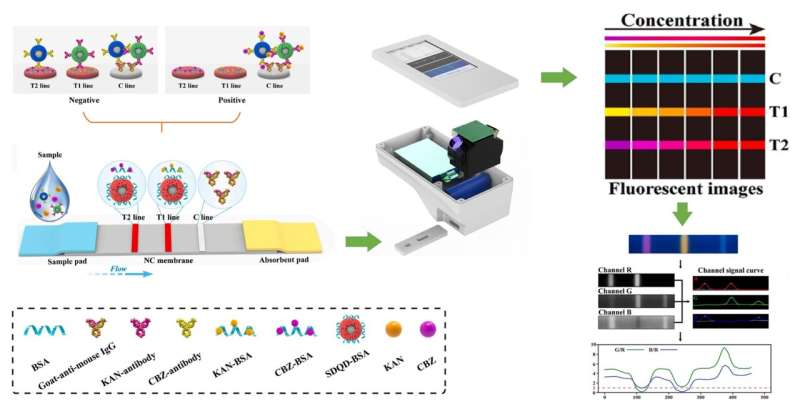This article has been reviewed according to Science X's editorial process and policies. Editors have highlighted the following attributes while ensuring the content's credibility:
fact-checked
trusted source
proofread
Novel system for highly sensitive detection of small molecule pollutants in food and the environment

A research team from the Hefei Institutes of Physical Science of Chinese Academy of Sciences, developed a novel competitive dual-channel color-tone change fluorescent immunochromatographic assay (CFICA).
"This new invention enables ultrasensitive detection of pesticide and veterinary drug residues," said Assistant Prof. Wang Shu, a member of the team. The research results were published in Sensors and Actuators: B. Chemical.
Excessive pesticide and antibiotic use can cause neurotoxicity, endocrine disruption, and cancer. Therefore, developing affordable, convenient, and sensitive detection technology is crucial for food safety and sustainable agriculture.
Immunochromatographic assays (ICA) are promising for on-site rapid detection due to their low cost and ease of use. However, their application for detecting trace-level small molecules is limited by insufficient sensitivity and semi-quantitative results.
In this study, researchers used polyethylenimine (PEI) self-assembly technology to prepare silica core double-layer quantum dot shell composite fluorescent labels in three different colors: red, green, and blue. The green and blue fluorescent labels were used as detection probes, while the red labels were used as encapsulation probes. This approach led to the development of a new competitive dual-channel CFICA.
The system proved highly effective in detecting the antibiotic kanamycin (KAN) and the fungicide carbendazim (CBZ) in real samples like milk, tea, lake water, and soil. It's at least 100 times more sensitive than current maximum residue limits (MRLs).
They also created a handheld fluorescence reader to conveniently measure the multicolor signals on CFICA strips quantitatively.
"We believe this system has strong potential for practical applications," said Wang Shu.
More information: Zhenmei Wang et al, A novel competitive color-tone change fluorescence immunochromatographic assay for the ultrasensitive detection of pesticide and veterinary drug residues, Sensors and Actuators B: Chemical (2024). DOI: 10.1016/j.snb.2024.136125
Provided by Chinese Academy of Sciences





















